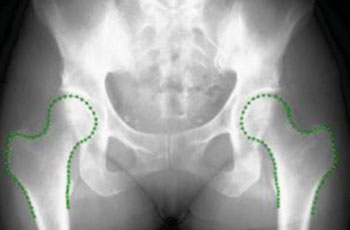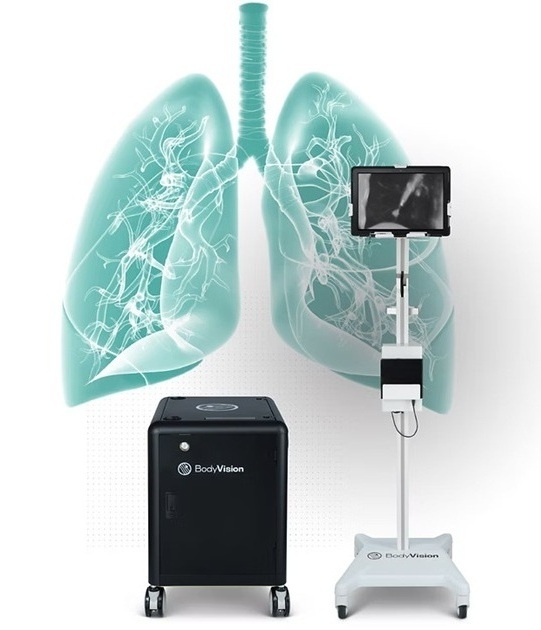Software Designed to Automatically Outline Bones in X-Rays
|
By MedImaging International staff writers Posted on 25 Nov 2014 |

Image: An image from the Bone Finder software (Photo courtesy of the University of Manchester).
Research into such as arthritis and other disorders will soon get a helping hand from new software that automatically outlines bones, saving thousands of hours of manual work.
There is a shortage of radiographers in the United Kingdom and because of an increasing requirement for researchers to work with large databases of radiograph images, the software, which is being funded by the UK Engineering and Physical Sciences Research Council, is being designed to automatically detect the shapes of bones in the images, instead of relying on individual researchers.
The system can already identify hips; however, researchers from the University of Manchester’s (UK) Institute of Population Health will now modify it to map out knees and hands and to be able to learn to identify other bones and structures within the body. The funding will allow further development to ensure the system is accurate enough that it can be used in hospitals to help provide faster diagnosis of problems in patients.
Tim Cootes, a professor of computer vision, said, “Mapping the outlines of bones from radiographs is hard work that takes time and skill. When researchers into conditions like arthritis are working with hundreds of images, it’s a very inefficient way of obtaining data. The idea of this software is to take the routine tasks out of human hands, so scientists can focus on drawing conclusions and developing treatments.”
The funding of GBP 300,000 lasts for three years and builds on earlier research that helped to develop the software, called Bonefinder, to identify problems and find the outlines of hips. This free software has been implemented by a number of research groups, including some based in Oxford and the US state of California.
Prof. Cootes added, “We have a growing problem with arthritis which affects more than 30% of over 65s and costs around GBP 30 billion to the UK economy yearly. “Ultimately we want to get this technology into hospitals where it can save time and resources for the benefit of patients.”
Related Links:
University of Manchester
There is a shortage of radiographers in the United Kingdom and because of an increasing requirement for researchers to work with large databases of radiograph images, the software, which is being funded by the UK Engineering and Physical Sciences Research Council, is being designed to automatically detect the shapes of bones in the images, instead of relying on individual researchers.
The system can already identify hips; however, researchers from the University of Manchester’s (UK) Institute of Population Health will now modify it to map out knees and hands and to be able to learn to identify other bones and structures within the body. The funding will allow further development to ensure the system is accurate enough that it can be used in hospitals to help provide faster diagnosis of problems in patients.
Tim Cootes, a professor of computer vision, said, “Mapping the outlines of bones from radiographs is hard work that takes time and skill. When researchers into conditions like arthritis are working with hundreds of images, it’s a very inefficient way of obtaining data. The idea of this software is to take the routine tasks out of human hands, so scientists can focus on drawing conclusions and developing treatments.”
The funding of GBP 300,000 lasts for three years and builds on earlier research that helped to develop the software, called Bonefinder, to identify problems and find the outlines of hips. This free software has been implemented by a number of research groups, including some based in Oxford and the US state of California.
Prof. Cootes added, “We have a growing problem with arthritis which affects more than 30% of over 65s and costs around GBP 30 billion to the UK economy yearly. “Ultimately we want to get this technology into hospitals where it can save time and resources for the benefit of patients.”
Related Links:
University of Manchester
Latest Imaging IT News
- New Google Cloud Medical Imaging Suite Makes Imaging Healthcare Data More Accessible
- Global AI in Medical Diagnostics Market to Be Driven by Demand for Image Recognition in Radiology
- AI-Based Mammography Triage Software Helps Dramatically Improve Interpretation Process
- Artificial Intelligence (AI) Program Accurately Predicts Lung Cancer Risk from CT Images
- Image Management Platform Streamlines Treatment Plans
- AI-Based Technology for Ultrasound Image Analysis Receives FDA Approval
- AI Technology for Detecting Breast Cancer Receives CE Mark Approval
- Digital Pathology Software Improves Workflow Efficiency
- Patient-Centric Portal Facilitates Direct Imaging Access
- New Workstation Supports Customer-Driven Imaging Workflow
Channels
Radiography
view channel
Machine Learning Algorithm Identifies Cardiovascular Risk from Routine Bone Density Scans
A new study published in the Journal of Bone and Mineral Research reveals that an automated machine learning program can predict the risk of cardiovascular events and falls or fractures by analyzing bone... Read more
AI Improves Early Detection of Interval Breast Cancers
Interval breast cancers, which occur between routine screenings, are easier to treat when detected earlier. Early detection can reduce the need for aggressive treatments and improve the chances of better outcomes.... Read more
World's Largest Class Single Crystal Diamond Radiation Detector Opens New Possibilities for Diagnostic Imaging
Diamonds possess ideal physical properties for radiation detection, such as exceptional thermal and chemical stability along with a quick response time. Made of carbon with an atomic number of six, diamonds... Read moreMRI
view channel
New MRI Technique Reveals Hidden Heart Issues
Traditional exercise stress tests conducted within an MRI machine require patients to lie flat, a position that artificially improves heart function by increasing stroke volume due to gravity-driven blood... Read more
Shorter MRI Exam Effectively Detects Cancer in Dense Breasts
Women with extremely dense breasts face a higher risk of missed breast cancer diagnoses, as dense glandular and fibrous tissue can obscure tumors on mammograms. While breast MRI is recommended for supplemental... Read moreUltrasound
view channel
New Incision-Free Technique Halts Growth of Debilitating Brain Lesions
Cerebral cavernous malformations (CCMs), also known as cavernomas, are abnormal clusters of blood vessels that can grow in the brain, spinal cord, or other parts of the body. While most cases remain asymptomatic,... Read more.jpeg)
AI-Powered Lung Ultrasound Outperforms Human Experts in Tuberculosis Diagnosis
Despite global declines in tuberculosis (TB) rates in previous years, the incidence of TB rose by 4.6% from 2020 to 2023. Early screening and rapid diagnosis are essential elements of the World Health... Read moreNuclear Medicine
view channel
New Imaging Approach Could Reduce Need for Biopsies to Monitor Prostate Cancer
Prostate cancer is the second leading cause of cancer-related death among men in the United States. However, the majority of older men diagnosed with prostate cancer have slow-growing, low-risk forms of... Read more
Novel Radiolabeled Antibody Improves Diagnosis and Treatment of Solid Tumors
Interleukin-13 receptor α-2 (IL13Rα2) is a cell surface receptor commonly found in solid tumors such as glioblastoma, melanoma, and breast cancer. It is minimally expressed in normal tissues, making it... Read moreGeneral/Advanced Imaging
view channel
First-Of-Its-Kind Wearable Device Offers Revolutionary Alternative to CT Scans
Currently, patients with conditions such as heart failure, pneumonia, or respiratory distress often require multiple imaging procedures that are intermittent, disruptive, and involve high levels of radiation.... Read more
AI-Based CT Scan Analysis Predicts Early-Stage Kidney Damage Due to Cancer Treatments
Radioligand therapy, a form of targeted nuclear medicine, has recently gained attention for its potential in treating specific types of tumors. However, one of the potential side effects of this therapy... Read moreIndustry News
view channel
GE HealthCare and NVIDIA Collaboration to Reimagine Diagnostic Imaging
GE HealthCare (Chicago, IL, USA) has entered into a collaboration with NVIDIA (Santa Clara, CA, USA), expanding the existing relationship between the two companies to focus on pioneering innovation in... Read more
Patient-Specific 3D-Printed Phantoms Transform CT Imaging
New research has highlighted how anatomically precise, patient-specific 3D-printed phantoms are proving to be scalable, cost-effective, and efficient tools in the development of new CT scan algorithms... Read more
Siemens and Sectra Collaborate on Enhancing Radiology Workflows
Siemens Healthineers (Forchheim, Germany) and Sectra (Linköping, Sweden) have entered into a collaboration aimed at enhancing radiologists' diagnostic capabilities and, in turn, improving patient care... Read more




















